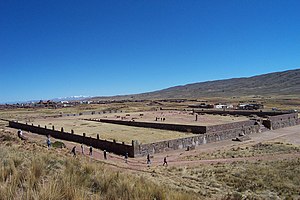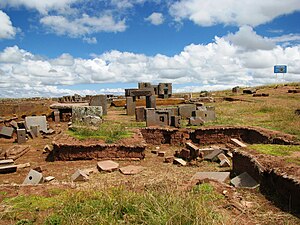
Back إمبراطورية تيواناكو Arabic Tiuanako mədəniyyəti Azerbaijani Cultura tiahuanaco Catalan Tiwanaku-Staat German Cultura tiahuanaco Spanish امپراتوری تیاهواناکو Persian Tiahuanaco kultura Croatian Negara Tiwanaku ID Civitas Tiuanacuensis Latin Тиуанако (культура) Russian
Tiwanaku Polity Tiahuanaco | |||||||||||||
|---|---|---|---|---|---|---|---|---|---|---|---|---|---|
| c. 600–c. 1000 | |||||||||||||
 Map of the Tiwanaku Civilization | |||||||||||||
| Capital | Tiwanaku, Bolivia | ||||||||||||
| Common languages | Puquina[1] | ||||||||||||
| Historical era | Middle Horizon | ||||||||||||
• Established | c. 600 | ||||||||||||
• Disestablished | c. 1000 | ||||||||||||
| |||||||||||||
| Today part of | Bolivia Peru Chile Argentina | ||||||||||||
The Tiwanaku Polity (Spanish: Tiahuanaco or Tiahuanacu) was a Pre-Columbian polity in western Bolivia based in the southern Lake Titicaca Basin. Tiwanaku was one of the most significant Andean civilizations. Its influence extended into present-day Peru and Chile and lasted from around 600 to 1000 AD.[2] Its capital was the monumental city of Tiwanaku, located at the center of the polity's core area in the southern Lake Titicaca Basin. This area has clear evidence for large-scale agricultural production on raised fields that probably supported the urban population of the capital. Researchers debate whether these fields were administered by a bureaucratic state (top-down) or through a federation of communities with local autonomy (bottom-up; see review of debate in Janusek 2004:57-73).[3] Tiwanaku was once thought to be an expansive military empire, based mostly on comparisons to the later Inca Empire. However, recent research suggests that labelling Tiwanaku as an empire or even a state may be misleading. Tiwanaku is missing a number of features traditionally used to define archaic states and empires: there is no defensive architecture at any Tiwanaku site or changes in weapon technology, there are no princely burials or other evidence of a ruling dynasty or a formal social hierarchy, no evidence of state-maintained roads or outposts, and no markets.[4]
Tiwanaku was a multi-cultural network of powerful lineages that brought people together to build large monuments. These work feasts integrated people in powerful ceremonies, and this was probably the central dynamic that attracted people from hundreds of kilometers away, who may have traveled there as part of llama caravans to trade, make offerings, and honor the gods.[5] Tiwanaku grew into the Andes' most important pilgrimage destination and one of the continent's largest Pre-Columbian cities, reaching a maximum population of 10,000 to 20,000 around AD 800.[3]
Outside of the core area in the southern Lake Titicaca Basin, there were Tiwanaku colonies on the coast of Peru, where highland people imitated Tiwanaku temples and ceramics, and cemeteries in northern Chile with elaborate grave goods in the Tiwanaku style. Despite the clear connections to these enclaves, there is little evidence that Tiwanaku leaders controlled the territory or people in between, that is, its territory was not contiguous. With a few important exceptions, Tiwanaku's influence outside the Lake Titicaca Basin was "soft power" that blossomed into a powerful, widespread, and enduring cultural hegemony.
The city of Tiwanaku lies at an altitude of roughly 3,800 meters (12,500 feet) above sea level, making it the highest state capital of the ancient world.[6]


- ^ Heggarty, P; Beresford-Jones, D (2013). "Andes: linguistic history". In Ness, I; P, Bellwood (eds.). The Encyclopedia of Global Human Migration. Oxford: Wiley-Blackwell. pp. 401–9.
- ^ Marsh, Erik (2019). "Temporal Inflection Points in Decorated Pottery: A Bayesian Refinement of the Late Formative Chronology in the Southern Lake Titicaca Basin, Bolivia". Latin American Antiquity. 30 (4): 798–817. doi:10.1017/laq.2019.73. hdl:11336/175804. S2CID 213080578.
- ^ a b Janusek, John (2004). Identity and Power in the Ancient Andes: Tiwanaku Cities through Time. New York: Routledge. ISBN 978-0415946346.
- ^ Goldstein, Paul (2007). "Settlement patterns and Altiplano colonization: new models and evidence from the Tiwanaku diaspora". In Williams, Verónica (ed.). Sociedades Precolombinas Surandinas. Buenos Aires. pp. 155–187.
{{cite book}}: CS1 maint: location missing publisher (link) - ^ Bandy, Matthew (2013). "Tiwanaku Origins and Early Development: The Political and Moral Economy of a Hospitality State". In Vranich, Alexei; Stanish, Charles (eds.). Visions of Tiwanaku. Los Angeles: Cotsen Institute of Archaeology. pp. 135–150. ISBN 978-0-917956-09-6.
- ^ Andrews, Anthony P. (1995). First Cities. Canada: St. Remy Press. p. 158. ISBN 0-89599-043-1. Retrieved 26 July 2022.